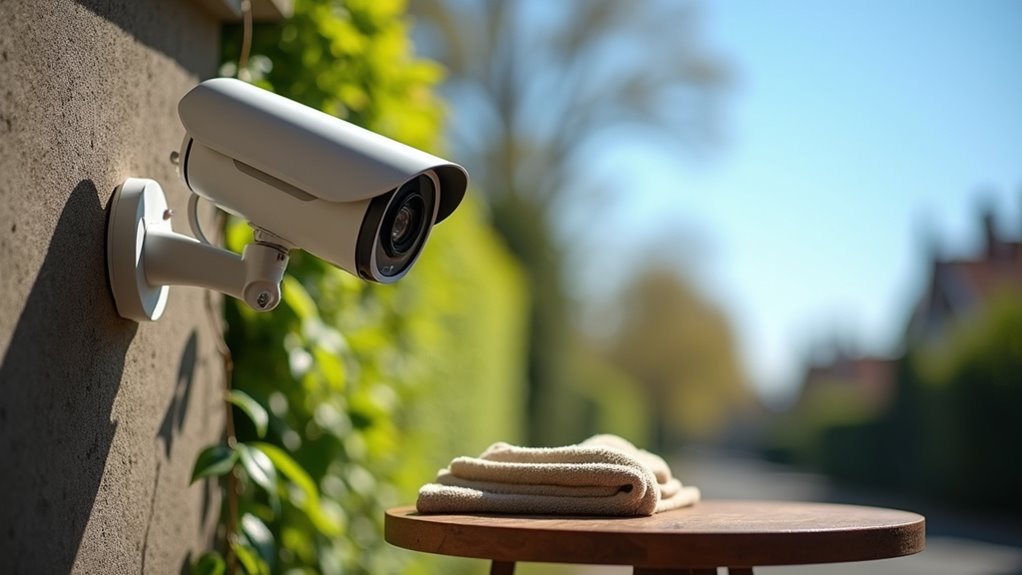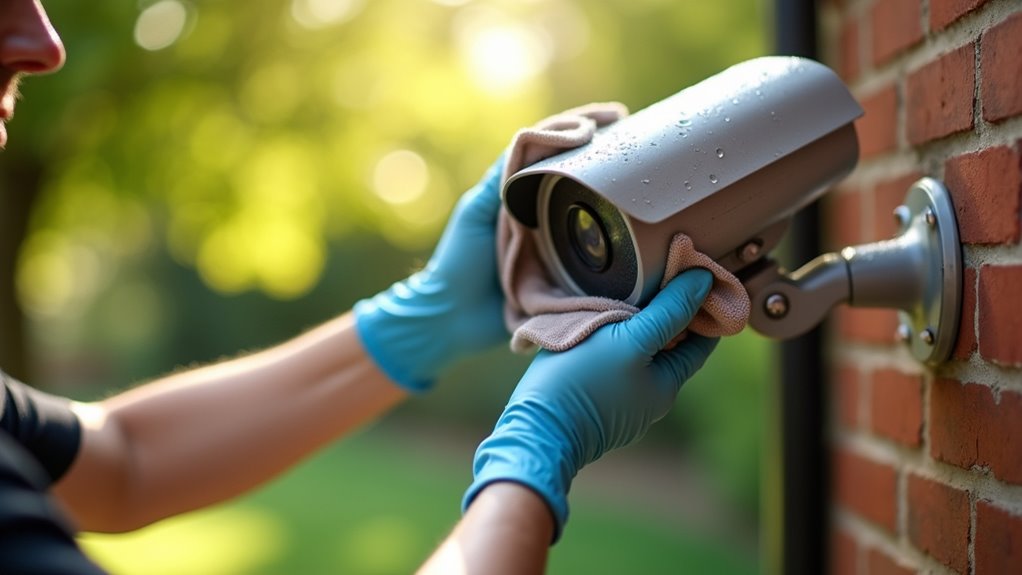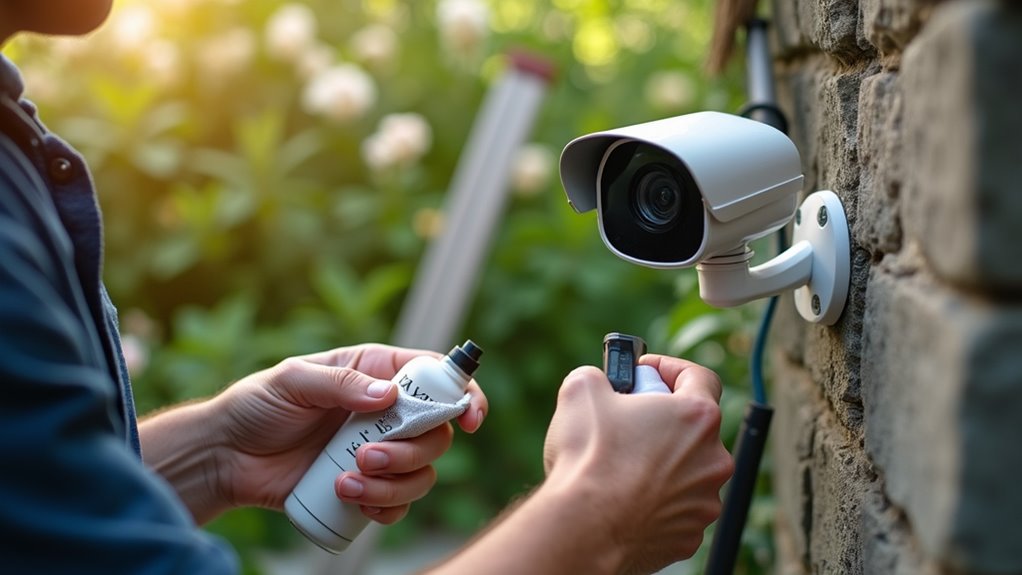Cleaning And Maintaining Outdoor Cameras
This post contains affiliate links. As an Amazon Associate, we earn from qualifying purchases.
To effectively clean and maintain outdoor cameras, begin by using compressed air to eliminate dust, followed by a soft brush for any stubborn dirt. Gently wipe the lens with a microfiber cloth and lens cleaner, and clean the camera body with a damp cloth. Regular inspections should be conducted every three months, or more often in high-traffic areas, checking for dirt, corrosion, and ensuring all features are functioning. Additionally, secure the cameras in place and trim any nearby plants to preserve clear views. Further insights and detailed steps will be provided later in the article for those seeking more information.
Essential Facts in 30 Seconds
- Regularly use compressed air and a soft brush to remove dust and dirt from the camera and lens.
- Clean the lens with a microfiber cloth and lens cleaning solution in circular motions for clarity.
- Inspect outdoor cameras every three months, or monthly in busy areas, to prevent dirt build-up.
- Check for cracks in camera housing and test all features during maintenance checks.
- Use high mounting and vandal-resistant housings to protect against damage and obstructions.
Cleaning Procedure for Outdoor Cameras
Cleaning outdoor cameras is important for clear video and security. Start by using compressed air to remove loose dust from the camera and lens. Keep a safe distance to avoid moisture damage. For stubborn dirt, use a soft brush. Don’t use anything rough that might scratch the lens. Additionally, ensure that the cameras are positioned to capture entry points clearly for optimal security.
Next, clean the lens. Put a few drops of lens cleaning solution on a microfiber cloth. Don’t apply it directly on the lens. Wipe the lens in circular motions from the center out. Use gentle pressure. Establishing a cleaning schedule can help maintain your camera’s performance over time.
For the camera body, dampen a microfiber cloth and wipe it carefully. Use cotton swabs for hard-to-reach areas. Control humidity to avoid damage.
After cleaning, check all connections when you reassemble the camera. Watch for dirt or moisture build-up. Following these steps keeps your camera working well.
Maintenance Frequency and Scheduling

Regular maintenance keeps outdoor cameras working well. Follow a clear maintenance checklist and plan your schedule. Check outdoor cameras every three months. They deal with more dirt and weather than indoor cameras. For cameras in busy areas or near the coast, check them monthly or every two months. This helps stop dirt and corrosion issues. Additionally, ensure that cameras are positioned in well-lit areas to enhance footage clarity during maintenance.
During maintenance, look for anything blocking the camera’s view. Test the power supply and check the lens focus. Don’t forget to update the software. These steps help keep images clear and the system safe.
Watch for changes in the environment. Adjust your checking schedule if needed. Consider professional servicing once a year. This can find hidden problems and help your system last longer.
Use these tips to ensure your outdoor cameras are always ready and effective.
Common Contaminants and Their Effects
Outdoor cameras can struggle with many contaminants that affect their performance. Dust is the most common problem. It smudges the lens and lowers clarity over time. This can hurt video quality and smart features, like infrared lights.
Dirt and grime can cover the lens and cause blurry images. Organic debris, like leaves and spiderwebs, can also block the camera’s view. This makes the camera less reliable. Regular cleaning ensures a crystal-clear picture of the property, enhancing the effectiveness of the surveillance system. Additionally, optimal coverage is achieved when cameras are kept clean and unobstructed.
Rain and humidity are other issues. They can lead to corrosion and foggy lenses. Fingerprints from handling the camera create smudges that reduce sharpness.
Airborne particles like pollen and pollution settle on the lens. This gradually decreases visibility.
To keep your outdoor cameras working well, care for the lens regularly. Check and clean the camera often. This helps ensure that your cameras provide clear and reliable footage.
Protective Measures and Prevention

To keep your outdoor cameras working well, use protective measures and prevention strategies. Start by mounting cameras high and securely. Use tamper-resistant screws and mounts. This helps improve security and prevents theft.
Choose vandal-resistant housings with high IK ratings. Weatherproof enclosures protect against bad weather and damage. Concealed cameras can capture evidence of individuals who may otherwise avoid visible surveillance, making them an effective addition to your security strategy.
Trim nearby plants to avoid blocking the camera’s view. This also helps with camouflage. Install motion-activated lights and tamper alarms. These alert you to any possible threats.
Secure the wiring to stop tampering or disconnection. Regularly check your cameras and update protective measures as the seasons change.
These steps will boost security and help your outdoor cameras last longer. They’ll always be ready to capture important moments.
Inspection and Testing Post-Cleaning
After cleaning your outdoor cameras, inspect and test them carefully. Start by checking the live feed on your monitor or app. Look for smudges or streaks on the lens. Make sure there’s no dampness or residue that might hurt image quality or damage the camera. Ensure that the camera placement allows for optimal entrance monitoring to capture anyone approaching your property.
Examine the camera housing and seals for any cracks or breaks.
Next, test all the camera features. Check if the pan, tilt, zoom, and night vision work properly. Take test images on a plain surface. This helps find any hidden spots or smudges. Adjust the settings to spot imperfections. Remember to document existing dust spots with a test shot to verify cleaning effectiveness later.
Review the images on a larger screen. Notice any problems? Repeat the cleaning process if needed.
Finally, document your inspection results. This helps track maintenance and ensures your cameras stay effective over time. Regular checks keep your outdoor cameras in top shape.
Tools and Materials Recommended

To keep your outdoor cameras working well, use the right tools and materials. Proper cleaning supplies help maintain clarity and performance.
Here are essential items to have:
- Microfiber cloths: These cloths trap dust and dirt. They won’t scratch your camera or lens.
- Lens wipes: Use optical-grade wipes made for cameras. They ensure safe and effective cleaning.
- Compressed air cans: These cans blow away dust from hard-to-reach spots. They help keep your camera clean without touching it. Regular maintenance helps prevent environmental challenges that can impair camera performance. Additionally, ensure that you regularly check the battery replacement status of your cameras for uninterrupted functionality.
Keep these tools handy. They can make a big difference in how well your cameras perform.
Frequently Asked Questions
Can I Use Household Cleaners on Camera Lenses?
Using household cleaners on camera lenses is a bad idea. They can ruin the special coatings on the lenses. Instead, use microfiber cloths. Pair them with lens cleaning solutions made just for camera lenses. These products help keep your lenses clean and clear. They also protect your investment. Proper care can extend the life of your camera lenses. Always choose safe options for the best results. Keeping your lenses clean ensures great photos every time.
How Can I Tell if My Camera Is Weatherproof?
Check your camera for weatherproof qualities. Look for its IP rating. This rating shows how well it resists water and dust. A high rating means better protection.
Examine the materials. Strong housing and sealed gaskets help keep water and dirt out. Cameras made for tough conditions can handle rain and snow.
Test it outside. If it works in different weather, it’s ready for adventures! Remember, a weatherproof camera is a great choice for outdoor photography.
What Should I Do if My Camera Gets Wet?
Wet cameras need quick action. First, turn off the camera right away. This helps stop water damage. Next, dry it out. Use silica gel packets or uncooked rice. These materials absorb moisture well. Place the camera in a bowl with these drying agents. Leave it there for at least 24 hours.
Keep the camera in a warm, dry spot. Avoid heat sources like hair dryers. They can cause more harm. After drying, check the camera carefully. Look for any signs of water damage. If it still doesn’t work, seek help from a professional.
Taking care of your camera can extend its life. Being quick can save it from serious problems.
How Do I Remove Insects From Camera Housing?
Your camera housing is like a fortress. To keep it insect-free, start by brushing away any webs. Use a small vacuum to remove debris inside. Spray some insect repellent around the edges of the housing. Regular cleaning helps protect your camera from pesky bugs. Stay vigilant and check your camera often. Keep it safe and ready for your next adventure!
Is There a Specific Temperature Range for Camera Operation?
Outdoor cameras work best in temperatures from -4°F to 122°F. Extreme temperatures can impact how well the camera functions. Always check your camera’s specifications. This ensures it can handle the climate in your area. Protect your investment by choosing the right camera for your environment.
Conclusion
Keeping outdoor cameras clean is important. Clean cameras capture every important moment like a watchful guardian. Dirt and grime can affect how well they work. Set a cleaning schedule that fits your routine. Check your cameras after cleaning. Make sure they function properly. A little effort goes a long way. You can extend the life of your cameras. Enjoy clear and reliable surveillance for years. Regular maintenance helps you stay secure. Don’t let dust block your view. Stay ahead of problems with simple care.






